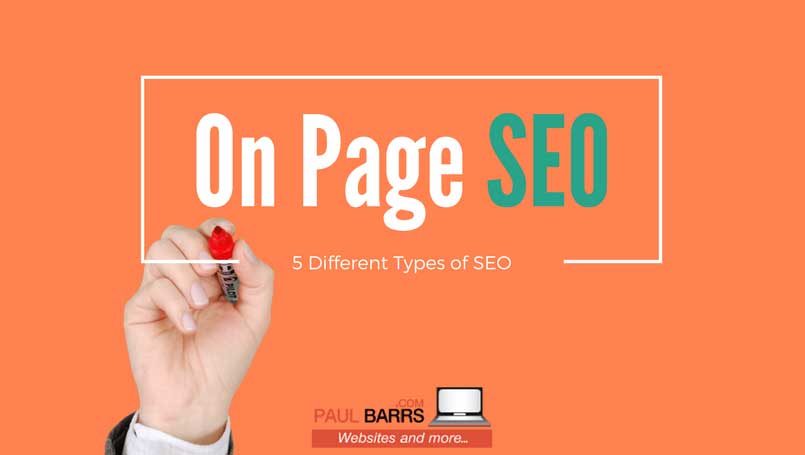
08 Aug On-Page SEO (5 Different Types of SEO Pt 1)
There are 5 major areas of SEO – if you focus on these before anything else, you can get solid results, fast, from your SEO efforts. The first is your OnPage SEO.
Hi there, folks. Paul Barrs signing in for a very quick video starting a new series today on different types of SEO you can use to boost traffic to your site. Now we’re going to do something a little bit different this time and spread them out one little step at a time so you can grab them in bite-sized chunks.
Number one in this video is your ON-Page SEO. Now here’s the thing about on-page SEO. There are a couple of different elements to it. In particular, in this video, we’re talking about the things that you really can almost, no matter what your experience level, make a difference to. So first area, on-page SEO, I want you to think of what the customers can see on their pages. Think about your content strategy. Think about if someone goes searching for you in search engines, what they see in the title and in the description that appears on Google. These are crucial elements of on-page SEO being different from the technical, which we’ll cover in a separate video.
So perhaps it’s easiest for me to just start from the top and work your way through. Here are some of the crucial areas of on-page SEO that you can adapt, edit, improve to make a difference to your rankings.
Number one, starting right up there at the top is your title, the meta title. This is what’s most commonly seen, say in Google and other search engines, when someone does a search, it’s the blue line. It’s that title across the top, and it’s done inside the editing area of your CMS software. With your title also is your description, that meta description, incredibly important to let users know what they’re going to see when they come through to your site.
Now moving down, there are others. We’re just covering the basics. I want you to now take a look and see what people see when they visit your page. The heading, that usually is a H1 heading tag, but it’s the first heading that people see, and then perhaps a sub-heading. These are important elements for the on-page SEO experience.
And then it moves across and deeper into the page, the actual content of the pages. Now people say to me, “Paul, what should I do in regard to keyword research, and what should I do into how those keywords go on the page? How often should we be using them?”
My answer is really simple. Talk about what you’re there to talk about so that people don’t think you’re talking about it one, too much, or two, not enough. See, here’s the thing. Don’t focus on the keyword for that particular page. Focus on the content for that page, and if you’re not talking about whatever your keyword is anyway, why the hell are you trying to focus on it? It should be part of the content.
And yes, there are other things you can do. Alt tags for the images, but make sure that the images are appropriate and related to the content. That’s the important thing. Look at the internal links from that page to another on your site or from other pages to that one. The link should only be there if it’s good for the customer. Don’t hyperlink on a keyword just for the sake of hyperlinking on a keyword. Make sure you link from that page to another if it’s either one, good for the customer, or two, leads to a conversion for you. Yes, both are important, but the content that’s on that page, whether it’s depth of content or short content, is highly relevant to the on-page SEO experience.
So let me finish with this, a general structure for your site. Usually, across the top, you’ll have your menu links. They go across there, and they lead to primary pages that you know talk about your products and services that customers are interested in. Yes, sure, your main primary pages, but then I want you to think of another type of page which we’ve been talking about now for years, the cornerstone content page. And these are really in-depth topical-based featured content pages.
And then there are your blog posts. Here’s how I do it. The menu across the top, these are the pages that usually, returning visitors want to be able to see and get to as quickly as possible. The homepage is for new visitors, showing them where to go on your site as quickly as possible. Your cornerstoned content pages, those deep, in-depth, authority article content pages, are for people who are just getting to experience you for the first time. They’re for building trust and authority.
And then your blog posts, shorter content pages, are those that introduce people to you to lead them to either cornerstone content or conversion pages.
It’s that simple, folks. The content is key, and there are some technical elements involved as well. So that’s number one of the main things that you can do for your site to improve your SEO. I look forward to talking to you in the next video.
Talk soon. Paul Barrs signing off from paulbarrs.com. Bye-bye.


